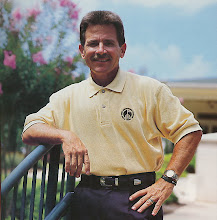Why is the turf on the driving range different from the fairways?
The answer is that the fairway turf reaches a state of maturity from many years of growth.
The range turf never reaches a state of maturity because we seed the divots 2 to 4 times a year depending on how many times we rotate through the range tee. When we begin the season on the lower level at the front of the tee we rotate back to it in a matter of 4 to 6 weeks. In that short time, the new seed that we have planted has germinated and begins to grow but it simply has not had time to become dense, thick and mature. We are constantly hitting on immature turf. We are re-seeding daily with the most aggressively growing seed variety on the market. There is no other turf variety that will solve the tight lie issue.
The photo below shows the thatch or pad that accumulates our fairway. This is a double edge sword. This pad allows your ball to sit up very nicely allowing you to sweep the ball off the turf. However, this same "pad" is one of the factors that limits ball roll on your tee shots.
That is a layer of organic material (decomposing roots, grass blades, etc.) located below the grass blades and the soil. It accumulates over time. Aerification and sand topdressing are measures used to maintain thatch in acceptable levels in the fairways. Zero thatch control is required on the range turf because the turf never reaches a mature enough state to begin developing this thatch layer.
The range is very actively used.
The photo below is of a cross section of the range tee turf. Notice there is no thatch or pad layer so the leaf blades are directly on thop of the soil. This would be representative of laying carpet in your home directly onto the concrete foundation without installing a layer of padding under the carpet.
This is the condition of the range
tee following the renovation
This photo shows how much of a small area of the range tee is displaced during a single day of hitting. It willl take this area 6 to 8 weeks to germinate, grow and begin to fill in. It would take several years for this area to mature and become dense like a fairway. However, we rotate the tee back to this same spot 2 to 4 times a year so the young turf is barely growing when we are hitting off of it again. It simply never has time to reach maturity. This photo shows a complete row of used turf during a single day. It takes 6 to 8
weeks for this area to cover again.


















